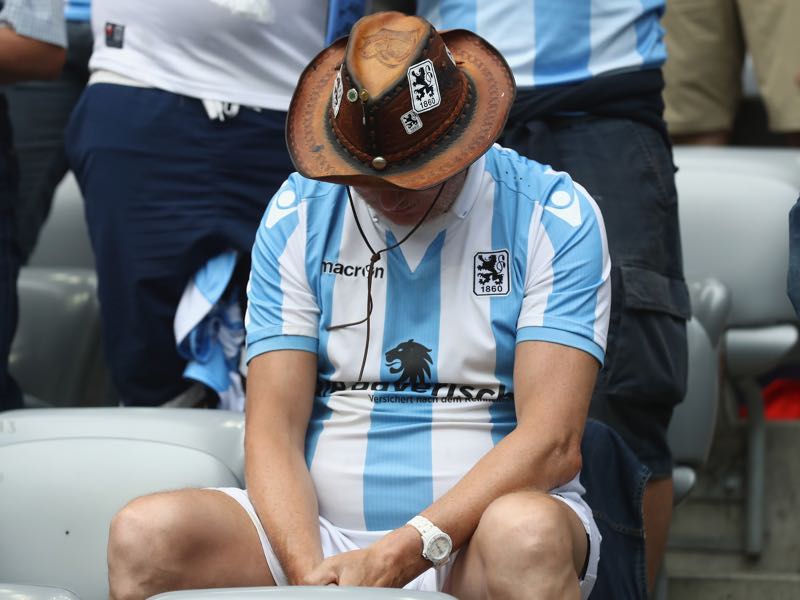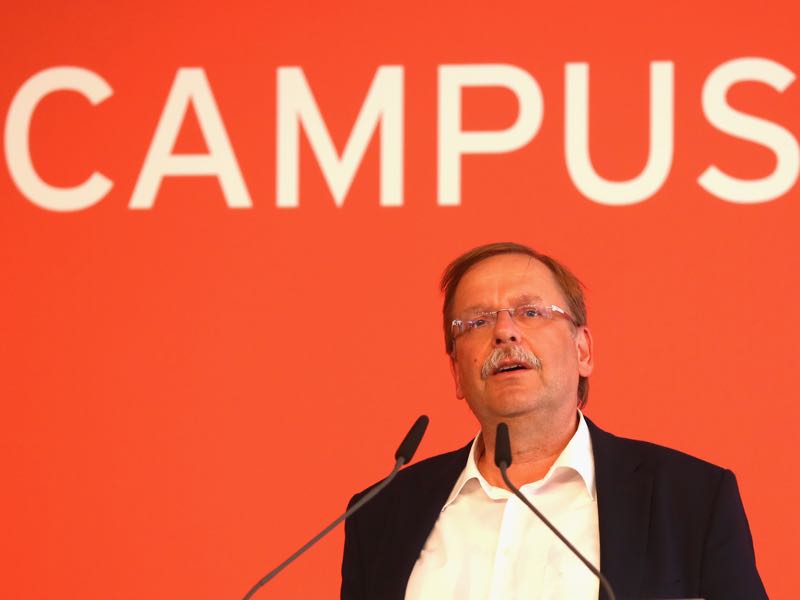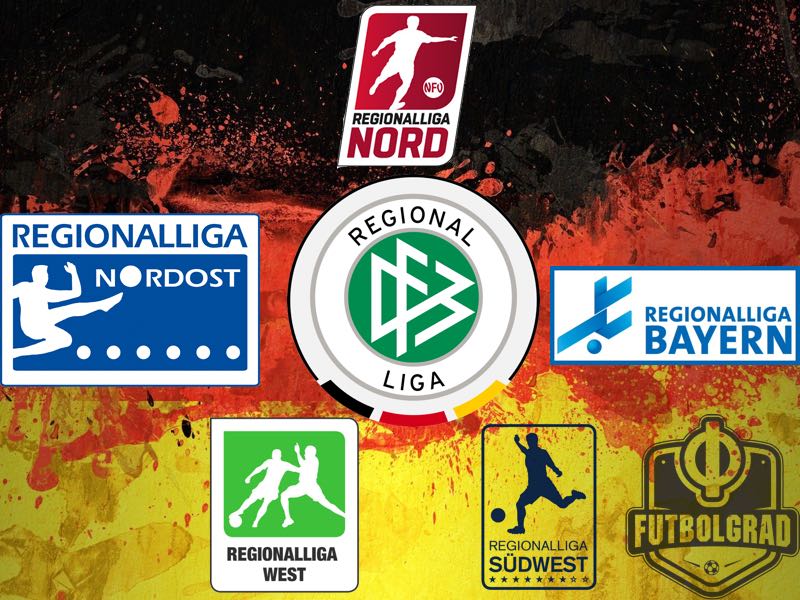Manuel Veth - On Tuesday 1860 München beat VfB Eichstätt 1-2 and now have an eleven point advantage over second-placed 1.FC Schweinfurt 05 on top of
Manuel Veth –
On Tuesday 1860 München beat VfB Eichstätt 1-2 and now have an eleven point advantage over second-placed 1.FC Schweinfurt 05 on top of the Regionalliga Bayern. Relegated from Bundesliga 2 straight to the fourth division after investor Hasan Ismaik refused to pay the licencing fee for Liga 3 1860 are now on course to win the league.
Unfortunately for the club winning their division would not result in an automatic promotion. The Regionalliga in Germany is subdivided into five divisions—North, West, Southwest, Northeast and Bavaria—but only three teams in the fourth division will be promoted to the Liga 3 at the end of the season.
As a result, the five champions of the North, West, Southwest, Northeast and Bavarian division as well as the runners-up from the Southwest division are drawn against each other in a home and away playoff format. This means that 1860 München, who are currently dominating their division with 11 wins two draws and just one defeat could easily win their division only to be drawn against the likes of Energie Cottbus, who are still undefeated in the Regionalliga Nordost. In the end, only one of those two big sides would go up to Liga 3.
The Regionalliga is the Bottleneck of German Football
The setup means that the Regionalliga has become a bottleneck for big clubs. Cottbus’ Regionalliga Nordost, for example, includes former East German giants BFC Dynamo and 1.FC Lokomotiv Leipzig. Previously former East German giants 1.FC Magdeburg and Carl Zeiss Jena were also stuck in the Regionalliga and only escaped the bottleneck with considerable effort.
The Regionalliga Nordost is not the only division in which several big clubs are stuck. The Regionalliga West includes former Bundesliga sides KFC Uerdingen, Rot-Weiß Oberhausen, Rot-Weiß Essen, Alemannia Aachen, Wuppertaler SV and SG Wattenscheid 09. On top of that ambitious clubs like Viktoria Köln, SC Verl and Bonner SC are also stuck in the fourth division. Only one of those teams, currently KFC Uerdingen, will go into the playoffs at the end of the season.
The picture is not any better in the Regionalliga Südwest. Here two teams qualify for the playoffs. Former Bundesliga sides Kickers Offenbach, 1.FC Saarbrücken and Waldhof Mannheim are occupying the top three in the league, which also includes former Bundesliga sides SSV Ulm 1846 and Stuttgarter Kickers.
Taking the current table into account Uerdingen, Oberhausen, Offenbach, Saarbrücken, Mannheim Energie Cottbus and 1860 München will be the likely candidates from the West, Südwest, Bayern, and Nordost divisions in the playoffs. SC Weiche 08 Flensburg, Hamburger SV II or Eintracht Norderstedt from the Regionalliga Nord in the playoffs will likely join all of those former Bundesliga sides.
Needless to say that the big clubs are all eyeing a possible dream draw against one of the clubs from the Regionalliga Nord at the end of the season. But more importantly, the big club’s of the Regionalliga want reform of the promotion system.
NOFV (Northeastern German Football Association) has recently suggested broad sweeping reforms to Germany’s fourth division. Founded as the successor of the DFV, the East German football association, the NOFV represents all East German clubs not playing in one of the top two divisions.
The NOFV Wants a New Liga 4
The NOFV has now suggested that the current Liga 3 format should remain untouched, but that a new Liga 4 should be introduced. The new fourth division would be still regionalised, but instead of five divisions would be restructured into two or three divisions. The NOFV also suggests that four instead of currently three clubs should be relegated from Liga 3.
The move by the NOFV is necessary because the association is currently representing seven out of the 20 clubs in the third division. Furthermore, with several big clubs in the Regionalliga, the NOFV may currently be the strongest political blog in the leagues governed by the German football association (DFB)—the DFL governs the Bundesliga and Bundesliga 2.
Before the introduction of a new Liga 4, the NOFV envisions a new promotion/relegation system in which three teams are promoted directly from the current Regionalliga system to the Liga 3, and a fourth side would be determined via a playoff round. The five Regionalliga divisions would rotate the direct promotion spot from season to season.

1860 München’s relegation to the Regionalliga Bayern means the club is now potentially caught in a bottleneck. (Photo by Alexander Hassenstein/Bongarts/Getty Images)
Meanwhile, the Bavarian clubs have asked to restructure both the third and fourth division. The so-called Wendelsteiner Vorlage envisions a Liga 3 with two divisions and the Regionalliga with two or three divisions. The Bavarian clubs are also strictly against expanding the Liga 3 from 20 to 22 clubs.
The problem with the Bavarian idea, however, is the fact that the current Liga 3 teams are strictly against a reform of Germany’s third division. Introduced in 2008 the Liga 3 was always a problem child of German football. Low television revenue and lack of advertisement money in relation with the Bundesliga 2 means that for many years many clubs struggle making the transition from the third to the second division or vice versa.
After nine years of existence, however, there are no signs that the Liga 3 has stabilised. The presence of seven former East German sides—Magdeburg, FSV Zwickau, Hallescher FC, Hansa Rostock, Chemnitzer FC, FC Carl Zeiss Jena and Rot-Weiß Erfurt—guarantees many attractive derbies, which in turn has meant a revival of Germany’s third division. Those East German clubs now feel that further reform could destroy the small plant of promise that has recently grown in Eastern German football as a result of a single division third league.
The Regionalliga Reform is a Reflection of Regional German Politics
The fact that teams from the NOFV dominate the competition, in fact, suggests that the East German football association will get their way and league reforms will move alongside the suggestions voiced by the NOFV. But German football politics are complicated.
The politics surrounding the football pyramid below the two top divisions in fact mirror that of Germany’s politics in general. Strong regional federations can dictate football politics in the country. One example is the powerful Bavarian Football Federation (BFV), which is the largest regional football association in Germany with 1.5 million members and 4624 clubs. The Regionalliga Bayern is the only local league within Germany named after one of the Länder (provinces), which in turn reflects not only the special status of the Free State of Bavaria within Germany but also the strength of the state within federal Germany.

Rainer Koch is one of the most influential sport functionaries in Germany. (Photo by Alexander Hassenstein/Bongarts/Getty Images)
With Rainer Koch at its head, the BFV has been an important voice during 1860 München’s relegation, and Hasan Ismaik’s subsequent fight with 50+1, and also the current possible restructuring of Germany’s lower divisions. Koch, a high-ranking judge and politician as well as the President of the BFV, has a senior position within the DFB and even acted as the president of the world’s largest sporting association between 2015 and 2016. With Koch as a power broker, the Bavarian clubs might very well get their wish.
The debate between the East German clubs and the teams from Bavaria will be interesting to follow. It will be interesting to watch how the powerful regional associations will handle this much-needed reform of the lower divisions. Because one thing is for certain the Regionalliga in its current format is not fair, but on the other hand, the Liga 3 in its present format is finally showing signs of success.
With all this in mind, the NOFV proposal makes the most sense. It guarantees that teams like 1860 München or Energie Cottbus, who are dominating their respective regional leagues are guaranteed promotion after winning the championships, and it also leaves the Liga 3 in its current format.
Manuel Veth is a freelance journalist and social media junior editor at Bundesliga.com. He is also a holder of a Doctorate of Philosophy in History from King’s College London, and his thesis is titled: “Selling the People’s Game: Football’s transition from Communism to Capitalism in the Soviet Union and its Successor States,” which will be available in print soon. Originally from Munich, Manuel has lived in Amsterdam, Kyiv, Moscow, Tbilisi, London, and currently is located in Victoria BC, Canada. Follow Manuel on Twitter @ManuelVeth.


COMMENTS